On The Jain Trail- Jain Circuit In South India
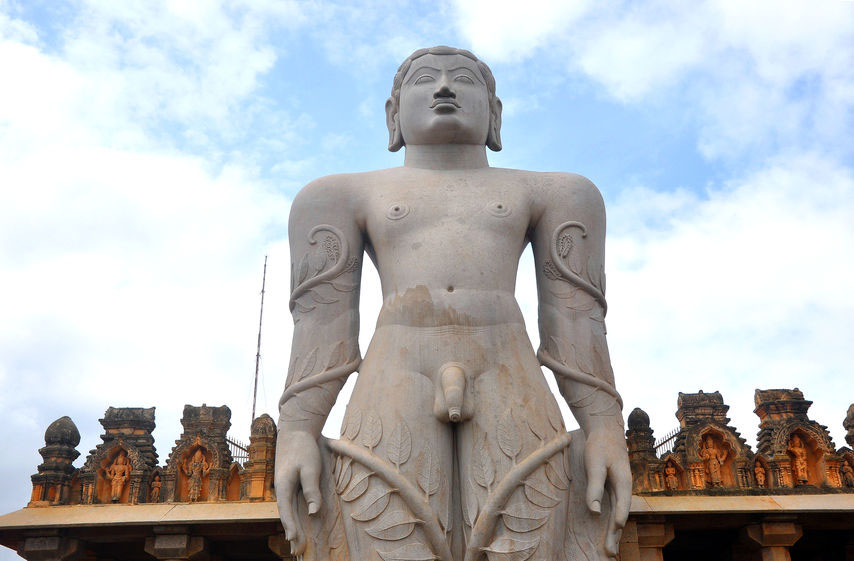 |
Not many people know that Karnataka has many important Jain pilgrim centers, temples and monuments. Shravanabelagola, Dharmasthala, Karkala, Moodbidri, Venoor, Humcha, Narasimharajapura will astonish the visitors by their vast and abundant Jain heritage. Jainism with their rich cultural heritage and noble preaching of non-violence and peace always enjoyed a significant status in Karnataka. Jainism had royal patronage in the state and the temples and monuments located in different parts of Karnataka are testimony to the glorious days when Jainism held sway over kannadigas. It seems unlikely but true that Jainism was Karnataka's State religion for quite a long period. It has strong roots in the State and the contribution of Jains to Kannada language and literature are many. Infact Pampa, the first Kannada poet was Jain.
Jainism acquired a superior place in the history of the region, of the Ganga, Rashtrakuta, Chalukya and other dynasties. Those who are interested in seeing important Jain centers in Karnataka visit only Shravanabelabola which attracts a large crowd every day irrespective of the season or occasion. They often miss-out on other equally important places, mostly in the coastal regions. In-fact these places are endowed with a rich cultural heritage and Jain legacy. It can attract not only Jains, but people of all religions who come here not for religious reasons but simply as tourists.
Day One: Visit Basadi, the ancient ruins of the lost city of the Pepper Queen. Leave Kundapur at 8.00 AM. Take a boat ride to the island. Visit the ruins of the old city. Visit Chaturmukha Basadi. Have a pure Jain lunch in the island. Start back at 3.00 pm. in the afternoon. Stop over either at Murudeshwar Beach Temple or Ottinene Beach or at Maravanthe Beach (any one) to see the sunset. Back to Kundapur.
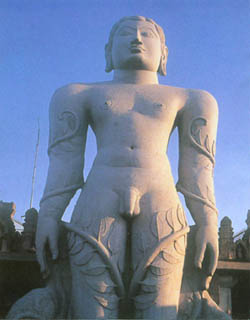 |
Day Two : Visit Varanga. Then proceed to Moodbidri. On the way visit Karkala Gomata Betta. Visit 1000 pillar temples, Jain Mutts & other important places. Visit to Soans Farms, a world of agricultural & botanical diversity. Those who are interested can shop for spices and fruits. Halt.
Day Three: Visit Dharmastala. Proceed to Shravanabelagola. Back to Hassan. Halt.
Day Four: Proceed to "HOMBUJA" Jain Temple. Evening back to Kundapur. Tour ends.
Optional: Visit Belur, Halebeedu temples where you can see the world famous Hoysala Architecture. ( This is not a Jain Temple.)
Temples of Coastal Karnataka : Moodbidri, Kollur Mukambika, Sringeri, Agumbe, Udupi Krishna Temple, Dharmastala, Subramanya, Murudeshwar, Idagunji.
Day One : Proceed to Moodbidri, the Jain Kashi of South and visit the Fruit Garden where you can see the Agricultural Diversity of our Land.
Day Two : Visit to Kollur, the Mookambika Temple. Hattiyangadi temple and AaneGudde Ganapathi Temple. Evening Boating at River Sowparnika.
Day Three : Visit to Sringeri Temple and Agumbe Sunset Point.
Day Four : Visit to Udupi Krishna Temple Malpe Beach.
Jain Kshetras : Dakshina Kannada has seen historic happier years by Jain and Jain Kings. Oldest Kannada literature is by the Jains. Jains here belong to the Digambara group. Jainism was spread throughout the district. Following are religious places of Jainism:
Karkala : Karkala has towering statue of Gomateshwara (43 feet). This statue was consecrated by Veerapandyadeva, the king of Bairarasa family of Karkala in 1432 AD on a rocky hill. There are life size statues of three Teerthankarasas well as one of Padmavathi Yakshi. The rulers also built Chathurmukh basadi at Karkala and famous Neminath basadi complex and the tall Manasthamba at Hariyangadi. Yearly celebrations are in February & once in 12 years Mahamastakabhisheka is performed. The next Mahamastakabhisheka will be performed in 2014.
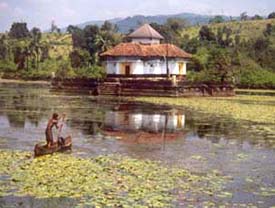 |
Moodabidri
Savirakambada Basadi : (Thousand Pillar Temple) built in 1462 AD-Basadi of 1000 pillars, famous for its stone sculpture. Mahadwar, Bhairadevi, Chitradevi, Namaskaara, Teerthankara and Garbhagruha are the 8 Mantapas here. The idol (8ft high) of Chandranatha is established in the garbha gruha. Supaarshwa and Chandraprabha Theerthankara idols are worth visiting. Navanaari kuinjara , a sculptural art piece that appears like an Elephant but nine dancers, are seen in the figure, is the famous art in this Basadi.
Venur : A 35ft Gomateshwara can be seen here. Like Karkala, in Venur also the Mahamastakabhisheka will be held once in 12 years. The last Mastakabhisheka was held in February 1999. So the next Mahamastakabhisheka will be held in the year 2011.
Dharmastala : Dharmastala is also a major pilgrim center for Hindus and Jains. The 39 feet Bahubali statue (175 tons) carved out of single rock by celebrated sculptor Ranjan Gopal Shenoy. The statue is consummate work of art and each of its lines and carves convey eternal values of a great religion and tradition.Dharmasthala represents religious tolerance. The Jain Teerthankara is worshipped on the same consecrate grounds as the native Devas as Lord Manjunath (Shiva). The priests are Vaishnavite and the guardian of the temple is Heggade but Jain by faith.
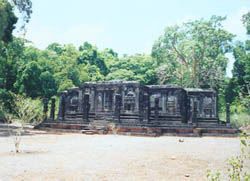 |
Basadi
The Ancient Ruins of The Lost City of Pepper Queen & Also Known As Basadi : The last & the most famous Queen Channa Bhairavi Devi ruled the Salva Kingdom few centuries ago. Her Kingdom was known for forest produces and spices especially pepper, all over the trading world. So she was known as Pepper Queen.
Forest produce being the main income, she built her capital in the middle of the forest on an island called 'Basadi'. It had over 70 Basadis (Jain Temples) of which you can see only ruins now. You have the Moodajina, Paarswanaatha, Vardhamaana and Chaturmukha Basadis here. All are well decorated by stony sculptures.
Hombuja : This is a small village in the Malnad. It was the capital of Santaras, the dynasty who ruled for over 1000 years uninterrupted. It has a very old Jain temple of a 7th to 9th centuries. Here you can see temples of Jina-Parsava, Padmavathi, and Kama-Jinalaya where a Bahubali image of CE 898 (as per the history) exists even today.
Other monuments here are Padmavathi Mandira, Panchakoota Basadi, Kshetrapala Mandir, Ashoka Basadi, Sri Parshwanatha Jina temple, The Pearl Pond, Kumuduvathi Theerta, Mahaveer Bhavana. In addition to this, you can also see the ruins of the temple, Silver Temple Cart, Elephant shed etc.
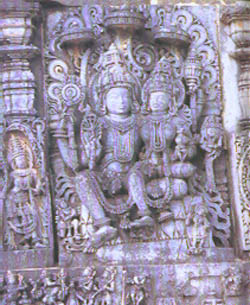 |
Belur - Halebid : This quaint hamlet - 38 kms from Hassan is located on the banks of the river Yagachi. It was once the capital of the Hoysala empire, today made unforgettable for its exquisite temples. The Channakeshava Temple is one of the finest examples of Hoysala Architecture. It took 103 years to complete and the reason is evident. The facade of the temple is filled with intricate sculptures and friezes with no portion left blank. Elephants, episodes from the epics, sensuous dancers... they are all there - awe - inspiring in their intricate workmanship. Inside are hand - lathe - turned filigreed pillars. The Kappe Chennigaraya Temple and the smaller shrines are well worth a visit.
Halebedu is 27 kms north-west of Hassan and 17 kms east of Belur. The temples of Halebid - like those of Belur - bear mute testimony to the rich, cultural hertiage of Karnataka. The Hoysaleswara Temple, dating back to the 12th century, is astounding for its wealth of sculptural details. The walls of the temple are covered with an endless variety of gods and goddesses, animals, birds and dancing girls. Yet no two facets of the temple are the same. This magnificent temple - guarded by a Nandi Bull - was never completed, despite 86 years of labour.
Shravanabelagola : The name conjures up images of great monolithic statue of Gomateshwara or Lord Bahubali. The colossal statue, carved from granite is the worlds tallest images creation of art which is 58.6 feet in high. Chavundandaraya, the Ganga general is said to have taken the enormous task of establishing the statue on the top of Vindhyagiri hill. The statue established around 1000 years back is a symbol of peace, tolerance and nonviolence. The nude image symbolizes renunciation and a man in his true himself.
The statue is clearly visible from a distance of 15 km. One has to climb hundreds of steps chiseled out in the rock to reach the statue. There are two hillocks in Shravanabelagola- Vindhyagiri or Doddabetta and Chandragiri or Chikkabetta. Vindhyagiri is the larger of the two where the statue is located, over looks Chandragiri, where large number of basadies including Chavundaraya basadi, Chandragupta basadi, Parshwanatha basadi, Bhadrabahu cave, Mahanavami mantapa etc are situated.
Kollur : The Mookambika Temple at Kollur (42 kms from Kundapur) is frequented by devotees from all over the country. Founded by Shri Jagadguru Adi Shankaracharya - the temple is known for the Panchaloha image of the Goddess Mookambika.
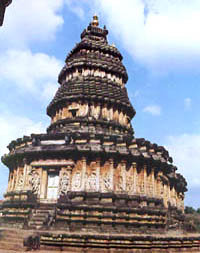 |
Sringeri : The legend says the great Vibhandaka Rashi & his famous son Rishyasringa built their Ashram at the foot of the Sahyadris and later Sringeri got its name from Rishyasringa. There hangs another tale for the association of the great philosopher, Sri Shankaracharya for his close association Sringeri. Once when he was touring the country, he sat on the banks of River Tunga to worship the sun. He saw a curious phenomenon there. A Cobra had spread its hood to give shade to a frog which was suffering from something. Seeing this Shankaracharya felt the spirit of peaceful coexistence in this place. So he decided to establish one of the four Mutts to be located at the four cardinal points.
Other than the nature, the Temples are the main attractions of Sringeri. There are as many as 40 major temples. Pilgrims have to climb up the hills, descend into valleys and cross the river to have Darshan of almost all the deities in the Hindu pantheon.
There is something to fascinate every type of the visitor, be he an archeologist, an architect, a sociologist or an educationist. A few temples deserve special mention. The finest among the temple from Architectural point of view is Vidya Shankar Temple. This is a very good example of the blending of the Dravidian & Hoysala style of temple building. The lack of vestibule & a lofty tower, tougher with presence of sculptured panels recall the Hoysala style. But the circumambulatory path (Pradakshina Path), the sculptured pillars, the highly ornamental cornice, the eaves resembling ropes, all these are distinctive features of Dravidian Style. The material used here is hard Granite, not soft soap stone. The harmonious blending of these styles make this temple a beautiful work of art. A special festival is held at the temple dedicated to Sri Sharada Devi during Navaratri. Also there are many temples dedicated to more prominent Rishis which are unique in its own way.
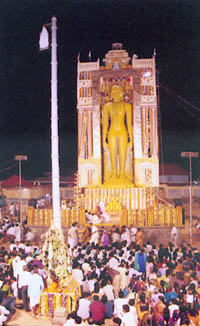 |
Students of Astronomy may be interested in studying the 12 sculptured pillars marking the signs of Zodiac, which are animals from Aries the Ram to Pisces the fish. As the sun moves from one Zone to the other, the rays fall on the respective pillar.
Udupi Sri Krishna Temple : Sri Krishna Temple was founded by Shri Jagadguru Madwacharya, 700 years ago. This temple complex consists of Sri Krishna Mutt, 8 Mutts - Kaniyoor, Sode, Puttige, Admar, Pejavara, Palimar, Krishnapura & Shiroor, 2 temples - Chandra Moulishwara & Anantheshwara (about 2000 years old) and 4 Upa Mutts - Uttaradi, Annayyaachar, Bhimankatte and Bhandarkere Mutt.
The right of worshipping of lord Sri Krishna will be transferred from one swamiji to another swamiji for every 2 years (among the 8 swamijis of 8 mutts). This celebration is called 'Paryayam' (on 17th Jan Night) which draws lakhs of devotees from all over the country. Paryaya Festival, Makara Sankraman, Choornotsava, Laksha Deep are few among the famous festivals in Udupi. Golden Chariot, Brahma Ratha, Geetha Mandira, are other attractions in the temple complex.
Varanga : The little known Jain temple of Varanga is just an hours drive from Kundapur. There are 3 main temples.
Chandranath Temple: is dedicated to Mulnayak Bhagwan Chandrapath & the idol is made of Chandrashila and one could see the light across the idol.
Jalmandir: This is an unique Shrine in the middle of the lake. On this tiny islet, you can feel the aura so typical of many Jaina holy places. In the year 1711 of Vikram era, Muni Shilvijaya came here on a pilgrimage. In the past, this was a rich and prosperous city. On the hills here, there were sixty temples. At present hundreds of people come here on Fridays for worship. The idols of 4 Tirthankaras are Bhagwan Parsvanatha, Bhagwan Neminath, Bhagwan Ananthanath, Bhagwan Shantinath.
Neminath Basadi: This temple is 1000 years old. The bronze idols of 24 Tirthankaras in Kayotsarg posture is in the hall. The idol of Mulnayak Bhagwan Neminath [5 feet tall] is in the Garbhagriha.
-----------------------------------------------------
Mail to : Ahimsa Foundation
www.jainsamaj.org
R200505